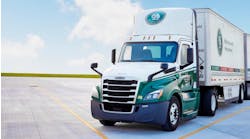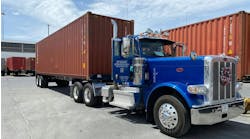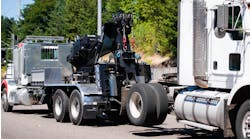For trucking, the hard economic times of late have produced one positive: lower insurance rates. While carriers large and small have been able to take advantage of this “soft” market, as insurance providers call it, the time will come soon, perhaps as early as the beginning of 2010, when this softness will subside. According to insurance experts, that means rates can only increase, and some trucking segments already are experiencing a shift in that direction.
The quarterly Transportation Insurance Pricing Survey (TIPS) compiled by the NIP Group, which is a specialized business insurance and risk management intermediary, reports that transportation insurance rate decreases are moderating and are down on average between 1% and 10%. In addition, more participants have reported modest rate increases across many segments, account sizes and lines of coverage during the second quarter of this year, notes Richard Augustyn, NIP's CEO.
“Our recent survey results show signs of a transportation insurance market where rates are beginning to level out,” he says. “The market appears to be in a transitional phase being led by established transportation underwriters trying to selectively drive up rates on key lines of business. It will be interesting to see … if this is an ongoing trend.”
Michael Miller, director of regional marketing for Progressive Insurance's commercial vehicles group, notes that premiums for truckers in general dropped 12% over the last 18 to 24 months, leading to an overall market contraction from $30 billion down to almost $26 billion. Yet the general consensus he's getting from his compatriots in the trucking insurance market is that rates are starting to stabilize and probably won't go down anymore. “My speculation is that we'll start to see rates trending upward by the end of this year,” he says.
NIP's Augustyn notes that the majority of TIPS respondents believe rates in the transportation insurance market are beginning to level out as observed by the slight firming of auto liability and motor truck cargo rates. Rate increases have also begun to emerge in some more specialized transportation segments, especially ambulance/paratransit, airport ground transporters and specialized carriers.
Still, Augustyn points out that one reason the trucking insurance market in particular remains soft with rates either steady or dropping is that many of the business fundamentals within the insurance industry remain poor, mirroring some of the same problems experienced by truckers themselves in the case of too much capacity and too little freight. In particular, new entrants are gaining market share as established transportation underwriters are holding the line on rates and are less likely to lower rates appreciably below expiring levels, he notes.
“There's still excess capacity in the insurance market and demand for insurance is still coming down, and that's helping keep rates down,” Augustyn explains. “As a result, the data we're looking at is still unstable, so rates could still hover in this soft market.”
COST DRIVERS
However, the reason rates will jump at some point soon for truckers is due to the burgeoning cost of claims. Though trucking mileage is down, resulting in fewer truck accidents, the costs resulting from those crashes are escalating rapidly, says Progressive's Miller. “When accidents do occur, there's a higher insurance payout today,” he explains. “That's primarily due to the high medical costs we're all experiencing today, but also because the cost to fix trucks is that much higher as well.”
He notes that modern trucks are equipped with much more expensive technology — especially to control emissions — and that's contributing to the higher repair bills. Also, while fatal truck crashes have been dropping for the past decade, the number of truck drivers killed in crashes has stayed roughly the same; and that monetary cost, aside from the horrendous loss of a human life, is largely borne by the trucking company.
According to Ralph Craft, senior transportation specialist for the Federal Motor Carrier Safety Administration's (FMCSA) Office of Analysis, Research and Technology, the percentage of truck driver fatalities rose from 13.1% in 2000 to 16.8% in 2007. While the percentage has risen, the actual number of drivers killed in crashes has stayed steady at approximately 800 for the past three years, FMCSA notes.
For truckers, though, the cost of even one accident can be enough to bankrupt a fleet. A few years ago, a study by the Pacific Institute for Research and Evaluation found that truck accidents alone cost the industry roughly $24 billion a year: $8.7 billion in productivity losses, $2.5 billion in resource costs, and quality-of-life losses valued at $13.1 billion. This averages out to roughly $183,000 per injury and $2.7 million per fatality, including medical expenses, emergency services, lost driver productivity, and quality-of-life losses.
CONTROLLING COSTS
Though insurance rates are projected to increase to cover the rising costs of claims, truckers large and small can use a variety of tactics, especially executive-level involvement in safety initiatives, to remain on the low end of such increases, says NIP's Augustyn. “There is no one factor that drives the improvement of a carrier's safety outlook [more], and subsequently insurance rates, than the commitment of the owner or CEO,” he points out. “A lot depends on the size of the company, but having that commitment — by appointing a safety and/or risk manager, by rewarding drivers for safe practices, by measuring and tracking incident rates — shows the insurer that the passion for safety is evident.”
Another important element is the motor vehicle records (MVRs) of truck drivers. This is especially critical for owner-operators and small carriers, stresses Progressive's Miller, as past losses are not reliable indicators of future performance.
“We write a lot of owner-operator business and fleets with two vehicles,” he explains. “In our market, the loss experience of these types of truckers has a certain randomness to it. Only for bigger fleets are past losses better predictors for future performance. So what we concentrate on are the driver and vehicle records: speeding tickets, out-of-service violations, etc. Other important things are the years of experience a driver has. Even operators with a CDL [commercial driver's license] and less than two years of experience can achieve discounts once they earn more years on their record without incidents.”
In the future, the type of truck used may become an important part of the insurance rate equation as well, along with various safety systems, though a specific dollar value for deductions in either case remains vague at present. “We're always looking at new variables,” says Miller. “A future focus for us is the type of truck in the operation and its safety characteristics.”
“The challenge with safety technology is that it takes time for evidence to emerge to show crash and claim reduction trends,” stresses NIP's Augustyn. “But at the very least, investing in such systems demonstrates that a fleet is serious about safety; that they are willing to put their money where their mouth is.”
The "Black Box"
A final wrinkle in the insurance picture is the impact “black-box” technology could have on rates, especially as the data gleaned from such devices about driver behavior could be key to providing discounts, says Mike Slattery, spokesperson for Liberty Mutual Agency Markets, a business unit of Boston-based Liberty Mutual Group. “These systems allow us to ‘score' commercial drivers; to determine with concrete evidence those that are good and those that need training, and then correlate that information back to insurance rates to get discounts,” he notes.
Slattery says Liberty Mutual is rolling out on a nationwide basis a new system called Onboard Advisor to monitor the driving behavior of commercial vehicle operators in relation to conditions such as traffic flow and weather. Vehicle performance data is combined with roadway information gleaned from GE Security's NavLogix GPS technology, using Google Street maps to record data such as vehicle speed, braking and cornering maneuvers in a second-by-second detail.
Fleets that install Onboard Advisor can realize savings on commercial auto premiums of up to 15% in the first year and up to 40% based on fleet performance upon coverage renewal through most of Liberty Mutual's eight regional companies, such as Golden Eagle Insurance, Liberty Northwest and Ohio Casualty, he notes.
“The more we know about fleets and the more we can determine those that are really good, the more money we all can save,” Slattery says.
“We've developed these tools so companies can take an active role in risk management and improve safety on their routes,” stresses Pete McPartland, president & CEO, Golden Eagle Insurance. “Loss prevention works best when it's a two-way street. Our commercial policyholders strive for consistent safety records, and the result is increased cost efficiencies and significant insurance discounts.”
At the end of the day, such technology is all about allowing fleet managers to take a much more active and immediate role in risk management, says Thomas Troy, executive vp and COO of Liberty Mutual's Regional Companies Group. “It puts a fleet manager in the driver's seat of every vehicle with daily, biweekly and monthly performance tracking,” he notes.
Fewer crashes= Lower premiums
According to a study by the Federal Motor Carrier Safety Administration (FMCSA) in 2006, drivers of large trucks and other vehicles involved in truck crashes are 10 times more likely to be the cause of the crash than other factors, such as weather, road conditions and vehicle performance. This finding underscores the importance of hiring quality drivers with nearly clean records, notes Peter Van Dyne, technical director of transport for Liberty Mutual's business market unit.
As important as it is to start off with a good driver, trucking companies also need to have an established, ongoing safety program to keep driver standards high and crash rates low, thus helping manage insurance rates. The relationship between lower crash rates and safety program practices, selection criteria and other management issues with trucking are quantified annually through Liberty Mutual's truckers' survey, Van Dyne says.
Every year for the past five years, the survey's findings show that trucking companies with above-average crash rates all adhere to a similar safety program structure. The common characteristics these companies share are high driver selection standards; driver performance expectations that are communicated to drivers; driver performance monitoring; actual performance versus expected performance comparison; plus programs to help change driver performance that does not meet expectations.
The benefits of these characteristics, such as high driver selection standards, include a 42% lower crash rate for companies with rollover alert systems in all or some of their trucks, and a 32% lower crash rate for companies that establish routes and use technology to track off-route miles. “However, keep in mind that without high selection standards, any in-cab technology is a waste of money,” stresses Van Dyne.
Prescreening to cut claims
One of the higher insurance costs trucking and other industries must deal with is workers' compensation and employers may begin to see increasingly higher frequency of job-related strain and sprain injuries as the physical conditioning of the American workforce is projected to decline.
Rob Teitsma, national business development manager for Cost Reduction Technologies (CRT), says trucking is squarely in the bull's-eye of workers' comp issues because of the sedentary nature of the driver's job combined with a high incidence of overexertion and repetitive motion injuries.
“You are sitting for long hours, potentially leading to a lack of exercise and weight gain, then engaging in repetitive activities that may lead to strain and injury, such as loading/unloading freight, hand-crank operation of trailer landing gear, even opening/closing heavy trailer cargo doors,” he says.
Strain and sprain injuries account for 31% of the days away from work for employees who have been on the job for less than one year, according to the Dept. of Labor. To make sure applicants have the musculoskeletal strength to handle a variety of trucking-related jobs, CRT developed a machine to measure muscle strength and range of motion for knees, shoulders and lower back.
Using patented measurement equipment and a proprietary algorithm, CRT can predict a person's fitness for duty and susceptibility to a sprain and strain injury. This machine, compliant with the Americans with Disabilities Act, allows companies to predict and avoid serious strain and sprain injuries before hiring; objectively establish return-to-work or fitness-for-duty readiness; and validate treating physician's work restrictions.
“The data will tell you if there is a physical mismatch between the person and the job they are expected to perform,” Teitsma says. “The machine generates a body index score that is then correlated to the strength level required by the job description.”
The whole point of this process is to screen out those applicants who don't meet the strength standards of the job in order to reduce overall workers' comp claims. “It's to identify people at a greater risk of injury due to the strains of the job, so you don't bring them on and expose both them and your company to risk,” Teitsma says.


